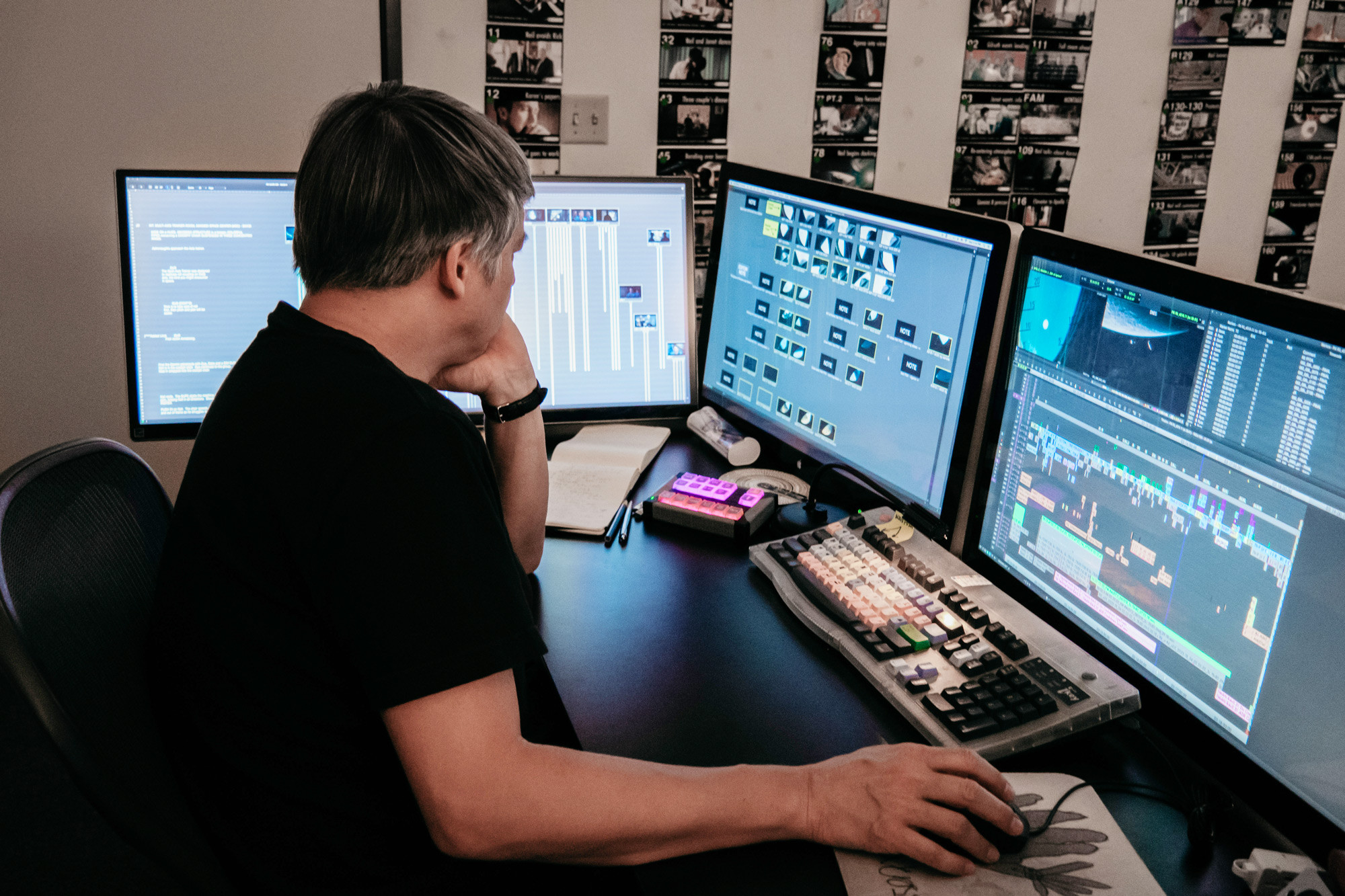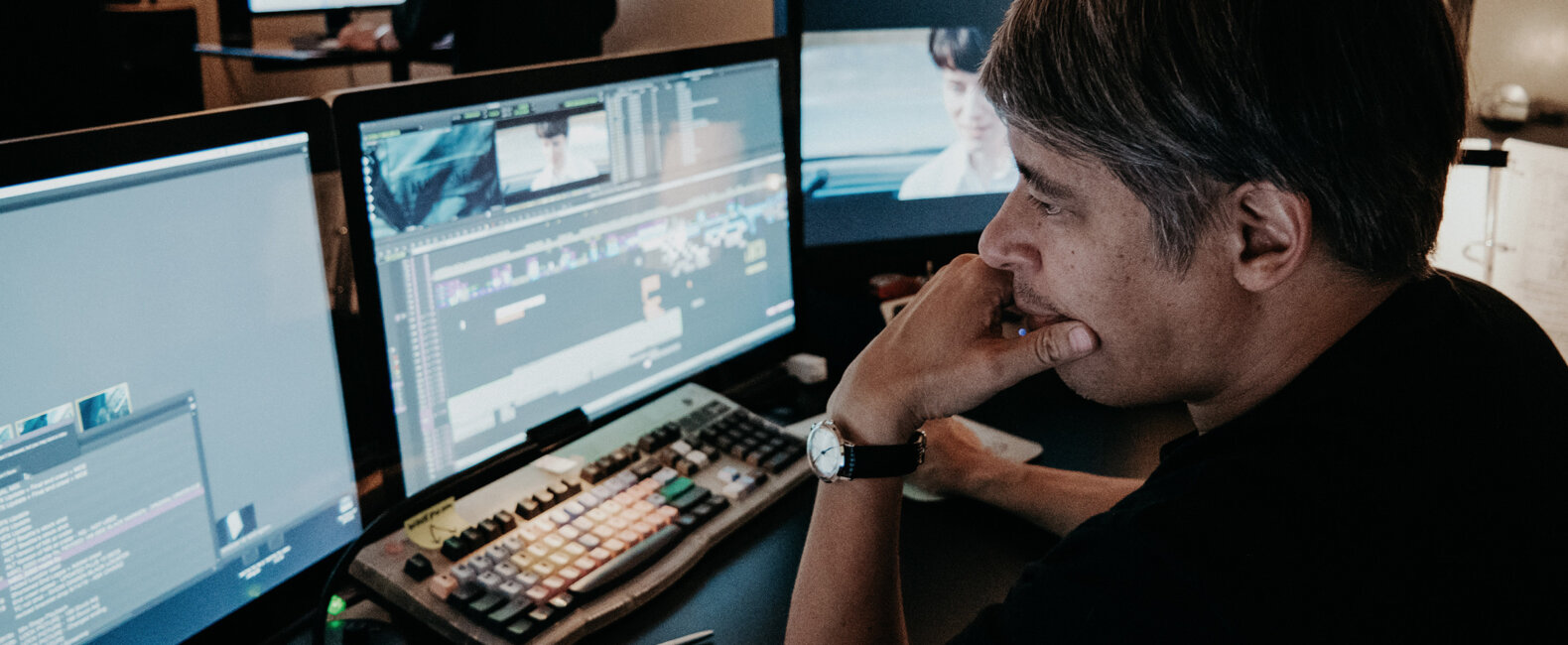You could point out a lot of reasons why Oscar-winner Tom Cross is one of the best editors in Hollywood. Maybe the most obvious, though, is evident in the diversity of his portfolio. Along with director Damien Chazelle, he’s crafted a tightly wound character study on obsession (Whiplash), a throwback love-letter to Hollywood via a musical (La La Land), and now a historical biopic unlike any we’ve ever seen in First Man. You probably couldn’t dream up three films that are more different than these, or three films edited as precisely and artfully.
For those of you who haven’t seen First Man, it’s not what you’d expect on paper. Anything but procedural, it blurs the lines between documentaries, blockbusters, and art films. It’s groundbreaking, particularly through its editing process. Tom and his team helped create a new form of major motion picture, built with stunning cinéma vérité footage from cinematographer Linus Sandgren (you can read his interview here).
The project presented both challenges and opportunities in the edit, which, in our book, Tom and his team met and exceeded. We spoke with Tom about how he pulled off this major feat in editing. But first, hear him explain how he set up the dizzying “Gemini spin” scene for success:
Musicbed: How did you get into the right headspace for First Man?
Tom Cross: Damien really does a lot of preparation. He does that by creating a list of reference films that inspire him, films that he feels the department heads should really watch and mull over. Also, on First Man, he created what we called “the notebook,” which was a huge binder full of reference photos, information, and interviews. It was the go-to for everything Damien felt was important to the movie, in terms of sound and textures and context.
So, that’s usually how I work with Damien. He’s done that on every project so far and each tool has grown. The notebook we had on First Man was the size of a phone book. It was dense, but it was great. But, really, the reference films are key for me. We had that on Whiplash, movies like The Social Network, Taxi Driver, Raging Bull. Damien always said he wanted the musical scenes in that film to feel like the boxing scenes from Raging Bull, very brutal and visceral. As an editor, that’s a really great thing to hear. With La La Land, of course, you had references like A Star is Born, It’s Always Fair Weather, and Meet Me in St. Louis. There were even movies like Boogie Nights, too.
What were your references for this project?
We had so many references. We had a plethora of archival NASA footage, which was this gritty, 16-millimeter stuff that was just beautiful. That was always a go-to. But, we also had references like Saving Private Ryan and United 93. We also looked at classic movies like 2001: A Space Odyssey, The Right Stuff, and Apollo 13. He wanted to look at those films to know what not to do because he didn’t want to tread on what those movies did so well. Damien thought it would be interesting to echo what he had seen in this NASA archival footage. He wanted it to be gritty and subjective, less modernist. Less space age. He wanted to show that spacecrafts were more machine age.
He was also really inspired by the cinéma vérité documentaries, 1960s movies by Frederick Wiseman, like High School. Also movies by Albert and Davis Maysles, like Gimme Shelter and Salesman. So, a lot of the shooting for First Man was very much like a documentary. In fact, he did two weeks of rehearsals before principal photography even started, to take Claire Foy and Ryan Gosling and put them with the child actors, get them all comfortable together. They were all in full makeup and hair, so Damien figured that it could be filmed. We had two weeks of unscripted, completely improvised material that was wonderful. We knew we’d use it but just didn’t know how — that’s something we found in the editing room.
How so?
Part of this documentary approach was that Damien wanted to be a fly on the wall in the space capsules, but also a fly on the wall in the Armstrong home. He figured we could bring to the table all of these personal aspects, these intimate moments that people knew nothing about. So, we kept all of that in mind and left ourselves plenty of room to rewrite in the editing room. The editing process is always the last rewrite. On First Man, we knew we’d be rewriting even more, because of the nature of how we shot it.
We had a lot of this improvised rehearsal footage that we really wanted to work into the film because it contained moments that were so unique and authentic. In some cases, we had scripted scenes that we cobble together with the rehearsal footage. There were actually a lot of scenes that changed quite a bit from the script.

Do you have a specific example?
Josh Singer had this amazing script, but as with anything else, things evolve. One thing that changed quite a bit was what Damien always referred to as “the moon and the kitchen sink.” We knew we were going to have to balance between the space missions and the more earth-bound family stories. This balance was going to be key to whether or not the story was going to work.
In the original cut, we had a lot more of the mission part of the story. We leaned more into the context of the Cold War — the movie originally began with an audio montage to build tension and suspense, to give more context for what America was going through. Those sort of references continued throughout the movie, too.
The more we worked through the editing, through the story, we realized it felt a little more conventional and a little too familiar. We found that when we juxtaposed a visceral life and death space mission along with Janet and the boys, it became very exciting to us. We knew we had to start removing certain elements of the missions and move into more family stuff.
We talked to Linus Sandgren earlier this week and he mentioned basic rules he and Damien put together. Did the editing side have similar rules?
We definitely did have some rules, but they’re a little more in the way of emotional rules and have to do with a gut feeling, rather than specific technical rules.
We wanted the earth-bound scenes to have a documentary feel, so that general feeling informed a lot of the cuts. It meant that anything too staged, a little too “Hollywood,” for lack of a better term, would have to go. I would analyze the footage and assess it differently than I would if it was La La Land.
For example, certain camera imperfections like moves and snap zooms, soft focus, or focus-finding moments, even rack focus moments were potentially usable. It allowed me to use certain moments where Linus was maybe trying to get on a character. Those little camera imperfections were fair game. It really allowed us to grab more great performance moments, simply because we could be open to them looking a certain way.
When I was cutting, I found that these little imperfections could be used for rhythmic purposes, too. You could use a little move or a little rack focus as visual punctuation. In the press conference scenes, Linus shot them in a beautiful vérité fashion and they really felt like a visual assault. You wanted to recognize that Neil felt like he was being attacked at the press conference. It was moments like that where we wanted the cuts to be felt.
Those little camera imperfections were fair game. It really allowed us to grab more great performance moments, simply because we could be open to them looking a certain way.
It’s interesting because when Linus saw an early rough cut of the film, he commented to me that he was surprised I used a lot of those imperfections, some of those little moments. But he liked it. I think he was surprised because when he was shooting the cinéma vérité style footage, he was covering these events like they were real-life events like a documentary cameraman would. He wasn’t just replicating cinéma vérité — it really was cinéma vérité.
So, in the case of mission control, for example, the way the set up the shoot was like a long stage play, where they would film a long swatch of mission control and every person in the control room had scripted dialog. Josh Singer had to come up with dialog for every person, even if they weren’t on screen. They would run this stage play and Linus and his operators would just kind of follow guys around the room. Every take that I got was different because they were filming it like a documentary. That meant if he zoomed into something or was finding focus, those little moments were just means to an end for him to cover the action.

How do you even organize that footage?
I will say organizing the footage was something we did in a different way than we had done before. I was lucky to have an amazing crew, my additional editors Harry Yoon and John To, who did some cutting on the film. I also had strong assistant editors — Derek Drouin and Jennifer Stellema — and they organized the footage in a way that was great for this verité style.
I work with Avid ScriptSync and that’s something I couldn’t do a movie without. It’s where you can go to the script, go to the dialog, or go to the transcribed action, and you can click the line and it’ll bring you all the footage. The challenge is that it doesn’t tell you what those pieces look like; it links you to the footage, but if you’re looking for something specific, it’s hard to find that.
So, my assistants had to do some additional organizing they normally wouldn’t do. They had to break down my footage either line by line or beat by beat. They would create these sequences within sequences, then they would organize it by size. They would have someone saying this line of dialog, but they would first stack together back to back, all the wide shots of that. Then they would have all the medium shots. Then they would have all the close-ups.
The reason for breaking the footage down in that specific way is that every take would be different and the camera is constantly changing focal length. So you can’t say, “Well, if I want a close-up, go to this setup,” because that’s not how it was on First Man. A given setup would contain wides, close, and mediums because the camera is constantly changing and roaming.
Was it difficult from a storytelling standpoint?
Well, it was challenging, in a different way than cutting conventional footage. I come from a little bit of a documentary background and that helped me out quite a lot. But, in a way, once you get into a groove you feel comfortable with the style and you say to yourself, “Okay, I can use this. I love the performance and it’s okay that there’s a little messiness in there, because we want that.” Then it becomes very liberating.

















































































